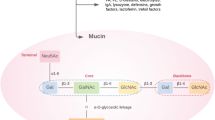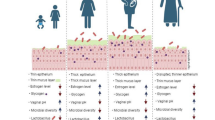Abstract
Bacterial vaginosis (BV) has been associated with severe medical consequences including induction of preterm birth and increasing susceptibility to infection by HIV and other genital tract pathogens. Although the mechanism by which BV induces these changes is not yet fully defined, the presence of BV is accompanied by immunologic changes in the lower genital tract environment. The most striking change is the induction of higher levels of proinflammatory cytokines, although this is not accompanied by increased levels of neutrophils. Increased cytokine levels are likely induced by bacterial products present in BV through innate immune recognition pathways such as the toll-like receptors. Recent studies show that changes in HIV susceptibility and HIV detection are associated with changes in bacterial flora. Further research is needed to identify the relative contributions of immune pathways and bacterial flora toward the pathogenic alterations that occur in BV.
Similar content being viewed by others
References and Recommended Reading
Schwebke JR: Gynecologic consequences of bacterial vaginosis. Obstet Gynecol Clin North Am 2003, 30:685–694.
Greenblatt RM, Bacchetti P, Barkan S, et al.: Lower genital tract infections among HIV-infected and high-risk uninfected women: findings of the Women’s Interagency HIV Study (WIHS). Sex Transm Dis 1999, 26:143–151.
Sewankambo N, Gray RH, Wawer MJ, et al.: HIV-1 infection associated with abnormal vaginal flora morphology and bacterial vaginosis [see comments]. Lancet 1997, 350:546–550. [Published erratum appears in Lancet 1997, 350:1036.]
Taha TE, Gray RH, Kumwenda NI, et al.: HIV infection and disturbances of vaginal flora during pregnancy. J Acquir Immune Defic Syndr Hum Retrovirol 1999, 20:52–59.
Thorsen P, Vogel I, Molsted K, et al.: Risk factors for bacterial vaginosis in pregnancy: a population-based study on Danish women. Acta Obstet Gynecol Scand 2006, 85:906–911.
Martin HL, Richardson BA, Nyange PM, et al.: Vaginal lactobacilli, microbial flora, and risk of human immunodeficiency virus type 1 and sexually transmitted disease acquisition. J Infect Dis 1999, 180:1863–1868.
Ness RB, Hillier SL, Richter HE, et al.: Douching in relation to bacterial vaginosis, lactobacilli, and facultative bacteria in the vagina. Obstet Gynecol 2002, 100:765.
Forsum U, Holst E, Larsson PG, et al.: Bacterial vaginosis—a microbiological and immunological enigma. Apmis 2005, 113:81–90.
Hill GB: The microbiology of bacterial vaginosis. Am J Obstet Gynecol 1993, 169:450–454.
Fredricks DN, Fiedler TL, Marrazzo JM: Molecular identification of bacteria associated with bacterial vaginosis. N Engl J Med 2005, 353:1899–1911.
Antonio MA, Hawes SE, Hillier SL: The identification of vaginal Lactobacillus species and the demographic and microbiologic characteristics of women colonized by these species. J Infect Dis 1999, 180:1950–1956.
Eschenbach DA, Davick PR, Williams BL, et al.: Prevalence of hydrogen peroxide—producing Lactobacillus species in normal women and women with bacterial vaginosis. J Clin Microbiol 1989, 27:251–256.
Hawes SE, Hillier SL, Benedetti J, et al.: Hydrogen peroxide-producing lactobacilli and acquisition of vaginal infections. J Infect Dis 1996, 174:1058–1063.
Amsel R, Totten PA, Spiegel CA, et al.: Nonspecific vaginitis. Diagnostic criteria and microbial and epidemiologic associations. Am J Med 1983, 74:14–22.
Nugent RP, Krohn MA, Hillier SL: Reliability of diagnosing bacterial vaginosis is improved by a standardized method of gram stain interpretation. J Clin Microbiol 1991, 29:297–301.
Hillier SL, Nugent RP, Eschenbach DA, et al.: Association between bacterial vaginosis and preterm delivery of a low-birth-weight infant. The Vaginal Infections and Prematurity Study Group [see comments]. N Engl J Med 1995, 333:1737–1742.
McGregor JA, French JI, Parker R, et al.: Prevention of premature birth by screening and treatment for common genital tract infections: results of a prospective controlled evaluation. Am J Obstet Gynecol 1995, 173:157–167.
Hauth JC, Goldenberg RL, Andrews WW, et al.: Reduced incidence of preterm delivery with metronidazole and erythromycin in women with bacterial vaginosis [see comments]. N Engl J Med 1995, 333:1732–1736.
Hillier SL, Kiviat NB, Hawes SE, et al.: Role of bacterial vaginosis-associated microorganisms in endometritis. Am J Obstet Gynecol 1996, 175:435–441.
Ralph SG, Rutherford AJ, Wilson JD: Influence of bacterial vaginosis on conception and miscarriage in the first trimester: cohort study. BMJ 1999, 319:220–223.
Cohen CR, Duerr A, Pruithithada N, et al.: Bacterial vaginosis and HIV seroprevalence among female commercial sex workers in Chiang Mai, Thailand. AIDS 1995, 9:1093–1097.
Taha TE, Hoover DR, Dallabetta GA, et al.: Bacterial vaginosis and disturbances of vaginal flora: association with increased acquisition of HIV. AIDS 1998, 12:1699–1706.
Cherpes TL, Meyn LA, Krohn MA, et al.: Association between acquisition of herpes simplex virus type 2 in women and bacterial vaginosis. Clin Infect Dis 2003, 37:319–325.
Mattsby-Baltzer I, Platz-Christensen JJ, Hosseini N, Rosen P: IL-1beta, IL-6, TNFalpha, fetal fibronectin, and endotoxin in the lower genital tract of pregnant women with bacterial vaginosis. Acta Obstet Gynecol Scand 1998, 77:701–706.
Platz-Christensen JJ, Mattsby-Baltzer I, Thomsen P, Wiqvist N: Endotoxin and interleukin-1 alpha in the cervical mucus and vaginal fluid of pregnant women with bacterial vaginosis. Am J Obstet Gynecol 1993, 169:1161–1166.
Hayashi F, Means TK, Luster AD: Toll-like receptors stimulate human neutrophil function. Blood 2003, 102:2660–2669.
Pioli PA, Amiel E, Schaefer TM, et al.: Differential expression of toll-like receptors 2 and 4 in tissues of the human female reproductive tract. Infect Immun 2004, 72:5799–5806.
Fichorova RN, Cronin AO, Lien E, et al.: Response to Neisseria gonorrhoeae by cervicovaginal epithelial cells occurs in the absence of toll-like receptor 4-mediated signaling. J Immunol 2002, 168:2424–2432.
Al-Harthi L, Spear GT, Hashemi FB, et al.: A human immunodeficiency virus (HIV)-inducing factor from the female genital tract activates HIV-1 gene expression through the kappaB enhancer. J Infect Dis 1998, 178:1343–1351.
Arbour NC, Lorenz E, Schutte BC, et al.: TLR4 mutations are associated with endotoxin hyporesponsiveness in humans. Nat Genet 2000, 25:187–191.
Genc MR, Vardhana S, Delaney ML, et al.: Relationship between a toll-like receptor-4 gene polymorphism, bacterial vaginosis-related flora and vaginal cytokine responses in pregnant women. Eur J Obstet Gynecol Reprod Biol 2004, 116:152–156.
Goepfert AR, Varner M, Ward K, et al.: Differences in inflammatory cytokine and toll-like receptor genes and bacterial vaginosis in pregnancy. Am J Obstet Gynecol 2005, 193:1478–1485.
Zariffard MR, Novak RM, Lurain N, et al.: Induction of tumor necrosis factor-alpha secretion and toll-like receptor 2 and 4 mRNA expression by genital mucosal fluids from women with bacterial vaginosis. J Infect Dis 2005, 191:1913–1921.
Hillier SL: The vaginal microbial ecosystem and resistance to HIV. AIDS Res Hum Retroviruses 1998, 14(Suppl 1):S17–21.
Rotstein OD, Pruett TL, Fiegel VD, et al.: Succinic acid, a metabolic by-product of Bacteroides species, inhibits polymorphonuclear leukocyte function. Infect Immun 1985, 48:402–408.
Wiggins R, Hicks SJ, Soothill PW, et al.: Mucinases and sialidases: their role in the pathogenesis of sexually transmitted infections in the female genital tract. Sex Transm Infect 2001, 77:402–408.
Robertson JA, Stemler ME, Stemke GW: Immunoglobulin A protease activity of Ureaplasma urealyticum. J Clin Microbiol 1984, 19:255–258.
Cauci S, Driussi S, Guaschino S, et al.: Correlation of local interleukin-1beta levels with specific IgA response against Gardnerella vaginalis cytolysin in women with bacterial vaginosis. Am J Reprod Immunol 2002, 47:257–264.
Basso B, Gimenez F, Lopez C: IL-1beta, IL-6 and IL-8 levels in gyneco-obstetric infections. Infect Dis Obstet Gynecol 2005, 13:207–211.
Hedges SR, Barrientes F, Desmond RA, Schwebke JR: Local and systemic cytokine levels in relation to changes in vaginal flora. J Infect Dis 2006, 193:556–562.
Genc MR, Karasahin E, Onderdonk AB, et al.: Association between vaginal 70-kd heat shock protein, interleukin-1 receptor antagonist, and microbial flora in mid trimester pregnant women. Am J Obstet Gynecol 2005, 192:916–921.
Alvarez-Olmos MI, Barousse MM, Rajan L, et al.: Vaginal lactobacilli in adolescents: presence and relationship to local and systemic immunity, and to bacterial vaginosis. Sex Transm Dis 2004, 31:393–400.
Imseis HM, Greig PC, Livengood CH 3rd, et al.: Characterization of the inflammatory cytokines in the vagina during pregnancy and labor and with bacterial vaginosis. J Soc Gynecol Investig 1997, 4:90–94.
Cauci S, Guaschino S, De Aloysio D, et al.: Interrelationships of interleukin-8 with interleukin-1beta and neutrophils in vaginal fluid of healthy and bacterial vaginosis positive women. Mol Hum Reprod 2003, 9:53–58.
Sturm-Ramirez K, Gaye-Diallo A, Eisen G, et al.: High levels of tumor necrosis factor-alpha and interleukin-1beta in bacterial vaginosis may increase susceptibility to human immunodeficiency virus. J Infect Dis 2000, 182:467–473.
Spandorfer SD, Neuer A, Giraldo PC, et al.: Relationship of abnormal vaginal flora, proinflammatory cytokines and idiopathic infertility in women undergoing IVF. J Reprod Med 2001, 46:806–810.
Yudin MH, Landers DV, Meyn L, Hillier SL: Clinical and cervical cytokine response to treatment with oral or vaginal metronidazole for bacterial vaginosis during pregnancy: a randomized trial. Obstet Gynecol 2003, 102:527–534.
Wennerholm UB, Holm B, Mattsby-Baltzer I, et al.: Interleukin-1alpha, interleukin-6 and interleukin-8 in cervico/vaginal secretion for screening of preterm birth in twin gestation. Acta Obstet Gynecol Scand 1998, 77:508–514.
Dinarello CA: Biologic basis for interleukin-1 in disease. Blood 1996, 87:2095–2147.
Diaz-Cueto L, Cuica-Flores A, Ziga-Cordero F, et al.: Genetic variation in the interleukin-8 gene promoter and vaginal concentrations of interleukin-8 are not associated with bacterial vaginosis during pregnancy. J Reprod Immunol 2005, 66:151–160.
Cohen CR, Plummer FA, Mugo N, et al.: Increased interleukin-10 in the endocervical secretions of women with non-ulcerative sexually transmitted diseases: a mechanism for enhanced HIV-1 transmission? AIDS 1999, 13:327–332.
Rein MF, Shih LM, Miller JR, Guerrant RL: Use of a lactoferrin assay in the differential diagnosis of female genital tract infections and implications for the pathophysiology of bacterial vaginosis. Sex Transm Dis 1996, 23:517–521.
Balu RB, Savitz DA, Ananth CV, et al.: Bacterial vaginosis and vaginal fluid defensins during pregnancy. Am J Obstet Gynecol 2002, 187:1267–1271.
Wiesenfeld HC, Heine RP, Krohn MA, et al.: Association between elevated neutrophil defensin levels and endometritis. J Infect Dis 2002, 186:792–797.
Yudin MH, Hillier SL, Wiesenfeld HC, et al.: Vaginal polymorphonuclear leukocytes and bacterial vaginosis as markers for histologic endometritis among women without symptoms of pelvic inflammatory disease. Am J Obstet Gynecol 2003, 188:318–323.
LeBlanc DM, Barousse MM, Field PL Jr: Role for dendritic cells in immunoregulation during experimental vaginal candidiasis. Infect Immun 2006, 74:3213–3221.
Hu J, Gardner MB, Miller CJ: Simian immunodeficiency virus rapidly penetrates the cervicovaginal mucosa after intravaginal inoculation and infects intraepithelial dendritic cells. J Virol 2000, 74:6087–6095.
Bafica A, Scanga CA, Schito M, et al.: Influence of coinfecting pathogens on HIV expression: evidence for a role of toll-like receptors. J Immunol 2004, 172:7229–7234.
Al-Harthi L, Roebuck KA: Human immunodeficiency virus type-1 transcription: role of the 5′-untranslated leader region [review]. Int J Mol Med 1998, 1:875–881.
Sha BE, Zariffard MR, Wang QJ, et al.: Female genital-tract HIV load correlates inversely with Lactobacillus species but positively with bacterial vaginosis and Mycoplasma hominis. J Infect Dis 2005, 191:25–32.
Cu-Uvin S, Hogan JW, Caliendo AM, et al.: Association between bacterial vaginosis and expression of human immunodeficiency virus type 1 RNA in the female genital tract. Clin Infect Dis 2001, 33:894–896.
Cohn JA, Hashemi FB, Camarca M, et al.: HIV-inducing factor in cervicovaginal secretions is associated with bacterial vaginosis in HIV-1-infected women. J Acquir Immune Defic Syndr 2005, 39:340–346.
Jamieson DJ, Duerr A, Klein RS, et al.: Longitudinal analysis of bacterial vaginosis: findings from the HIV epidemiology research study. Obstet Gynecol 2001, 98:656–663.
Author information
Authors and Affiliations
Corresponding author
Rights and permissions
About this article
Cite this article
St. John, E., Mares, D. & Spear, G.T. Bacterial vaginosis and host immunity. Curr HIV/AIDS Rep 4, 22–28 (2007). https://doi.org/10.1007/s11904-007-0004-y
Published:
Issue Date:
DOI: https://doi.org/10.1007/s11904-007-0004-y




